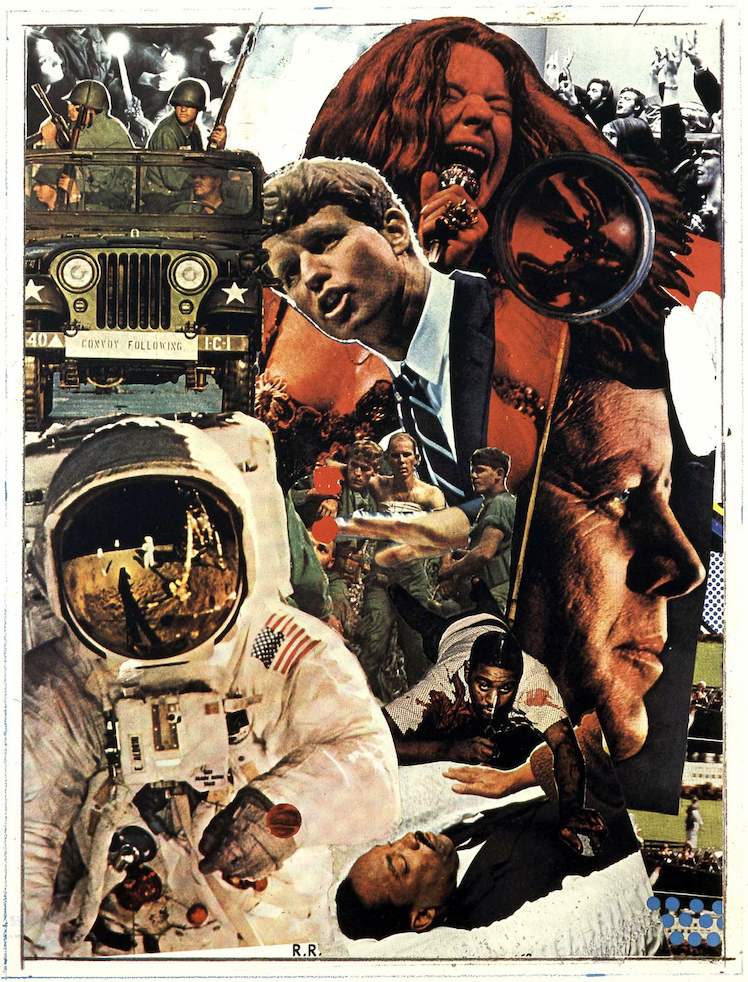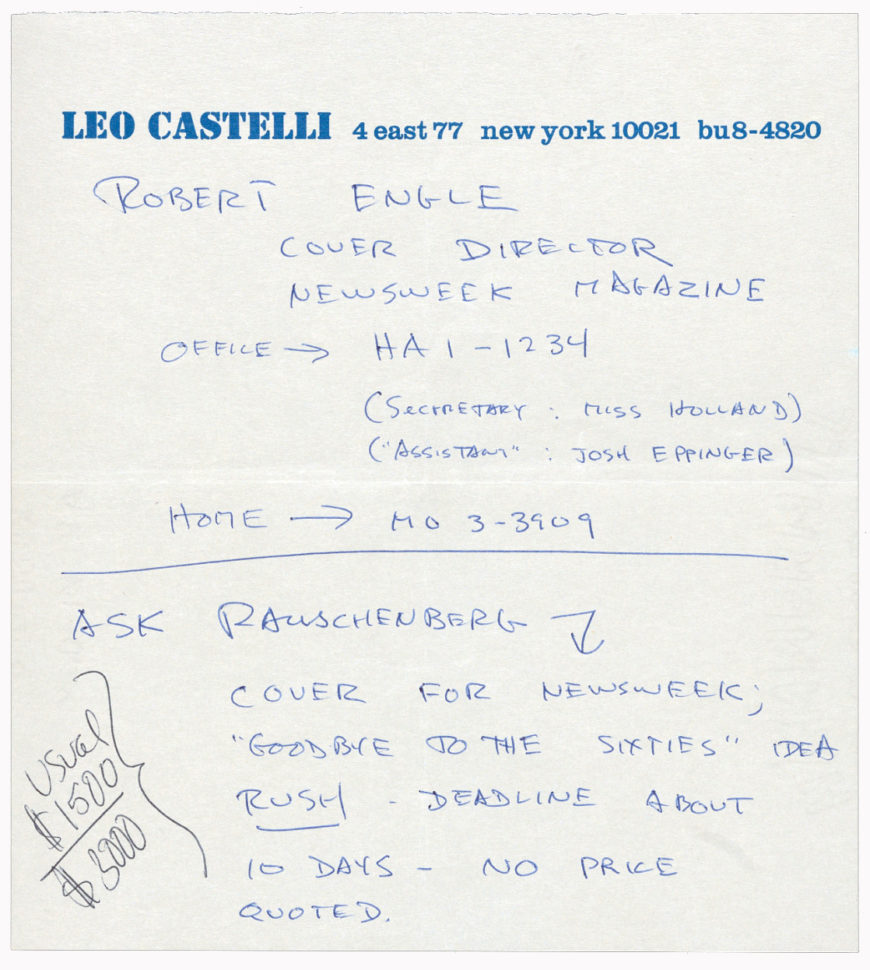
Note from the Castelli Gallery, Leo Castelli Gallery records (Archives of American Art, Smithsonian Institution, box 17, folio 34. Image courtesy of the Rauschenberg Foundation)
In 1970, Newsweek magazine commissioned and ultimately rejected a cover image from Robert Rauschenberg. The artist was asked to create an image that commemorated the 1960s, a tumultuous decade defined by violence and by protests over the Vietnam War, the civil rights movement, feminist and gay rights advocacy, and an emergent counter culture. The theme was “Goodbye to the Sixties,” according to a note penned on letterhead from the Castelli Gallery.
Signs is a montage of iconic symbols of 1960s culture. Figures of differing size appear to float and overlap as if they are the occupants of a distorted dream landscape. A convoy of American soldiers on the upper left and a group of students who protest the Vietnam War in black-and-white on the right bookend a cascade of figures: the Blues singer Janis Joplin (who died of a drug overdose in 1970) and who is overlaid in a wash of red the color of blood; the slain senator Robert (Bobby) Kennedy is just below her partially enveloped by that same red. In profile view, dominating the bottom right side of the composition, is his brother John F. Kennedy whose presidency was ended by assassination in 1963. If one detected a morbid sensibility emerging here, it would only be intensified by the addition at center of a wounded soldier assisted by two uniformed ones, and below this, the figure of a bloodied Black figure reaching over the body of slain civil-rights leader Martin Luther King Jr. whose prone position anchors the print at bottom.
Did Newsweek perceive the work to be too darkly political or even anti-war? After the image was rejected, Rauschenberg’s dealer Leo Castelli decided to issue the work as a limited edition of screenprints entitled Signs.
Is the astronaut, who looms large at bottom left, an attempt to balance this rather despairing view of the sixties? The glass face covering of his helmet reflects an image of the moon landing. But the remainder of his body, sheathed in a space suit with an American flag prominent on his left shoulder, is splattered with circles of red suggesting splatters of blood, as if a decade of war and social upheaval had sullied the euphoria that had greeted President Kennedy’s expansion of the U.S. space program in 1961.
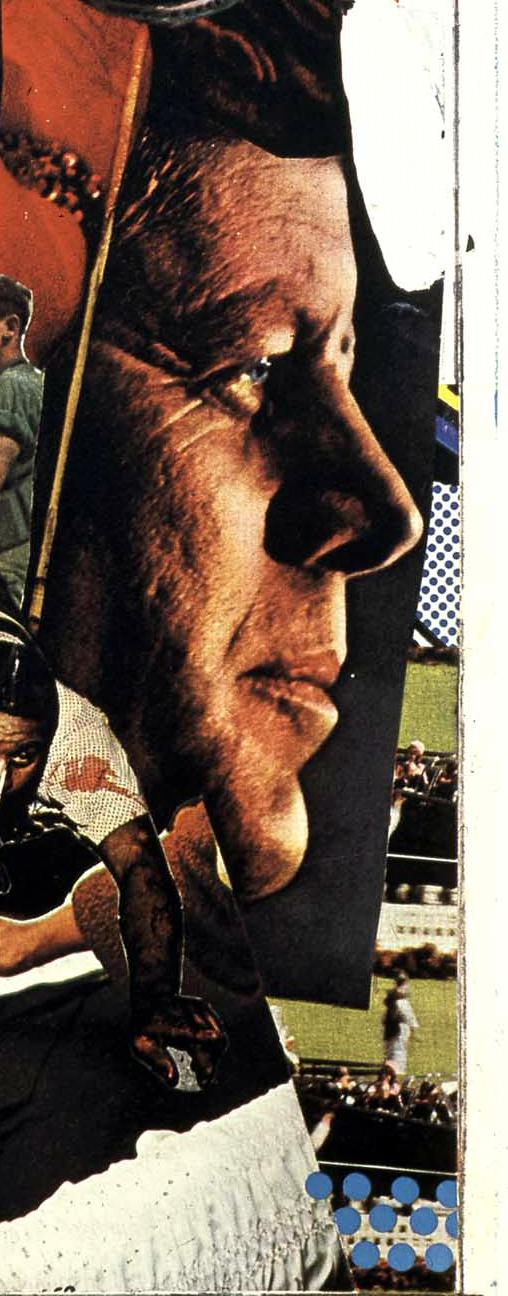
Robert Rauschenberg, detail of the center-right side, Signs, 1970, screenprint, 109.22 x 86.36 cm (MoMA)
There are few buoyantly optimistic “signs” in this work. Partially obscured on the lower middle right of the print is the fragment of a work by the Pop artist Roy Lichtenstein whose cartoon-inspired paintings were meticulously constructed to resemble the benday dot printing technique used in advertising imagery. Below that is a fairly typical American scene of baseball. But both are crowded to the right and dominated by the profile image of Kennedy.
Is it any wonder that Newsweek declined to put the image on its cover? Instead of a cleanly graphic image with a clear point of view, the usual Newsweek cover of that time, Rauschenberg had given them the bad dream of a long decade: war, civil unrest, and racial injustice. It is important to note that despite its somewhat incendiary imagery, Signs represents no singular political viewpoint. This is consistent with the artist’s work as a whole. While often controversial, Rauschenberg was never an overtly political artist. There is no commentary here; indeed, the haphazard arrangement of imagery without a clear hierarchy, center, or any other kind of compositional ordering complicates any traditionally iconographic approach.
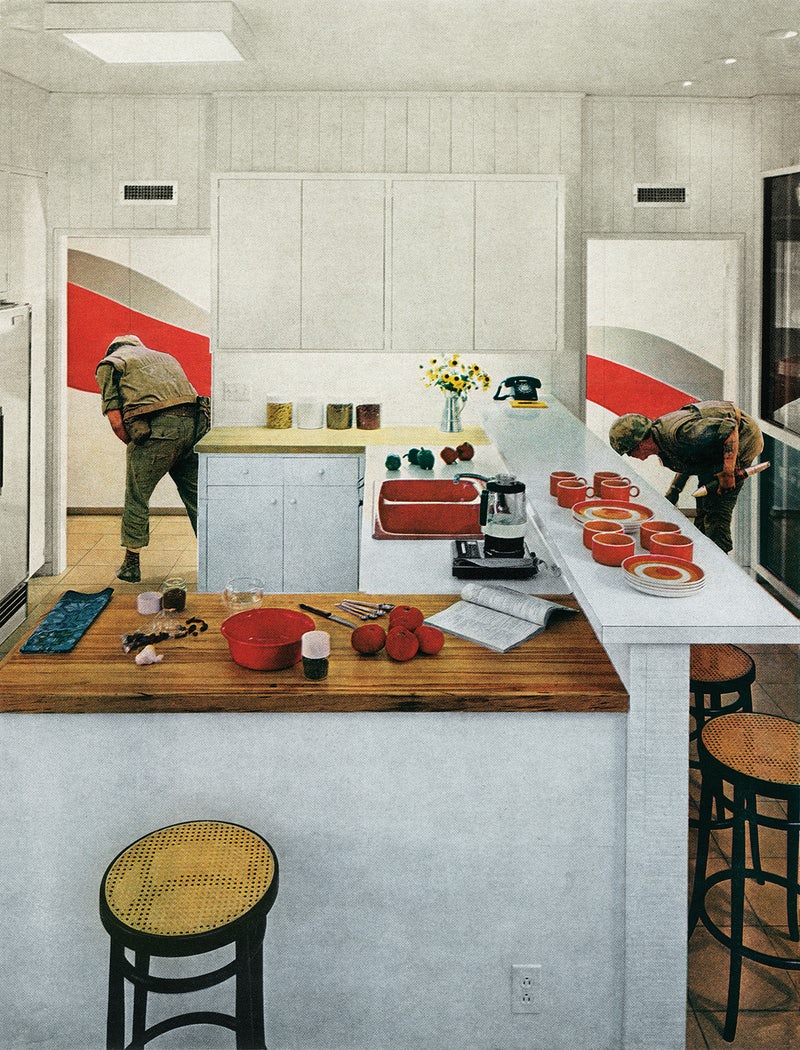
Martha Rosler, “Red Stripe Kitchen,” from the series House Beautiful: Bringing the War Home, c. 1967–72, photomontage (© Martha Rosler)
As a point of comparison, Martha Rosler’s photo-montage work House Beautiful: Bringing the War Home, c. 1967–72, adopted a similar tactic in mashing together disparate images from Life Magazine of home interiors and wounded Vietnamese citizens, hers was clearly an activist intervention and an anti-war statement. Rauschenberg’s work was much more ambiguous, a trait that he had continued since the 1950s when he began creating artworks known as combines (these were primarily assemblages of found objects, images, fabrics, and other sundry items).
After the 1950s, Rauschenberg began producing flat images (such as Signs) alongside the three-dimensional, sculptural combines. The process was similar, but instead of found objects, he used media sources. Rauschenberg’s collaging of imagery abandoned compositional hierarchy in favor of seemingly arbitrary placement. This led the art critic and historian Leo Steinberg to describe this new direction in the artist’s work as a “Flatbed picture plane,” conjuring an image of the horizontal bed of a printing press. Rauschenberg availed himself of various technologies of image-making often used commercially, like silkscreen or screen-printing, and popularized by Pop artists during the 1960s. Often interspersed with his own photographs, these images were splayed next to one another in random fashion.
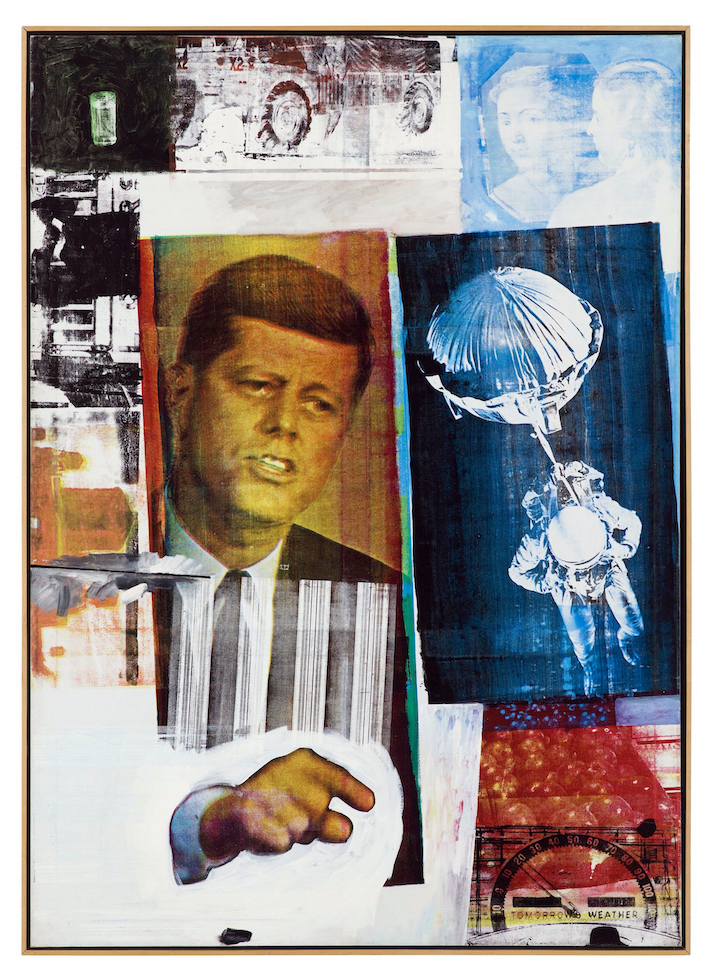
Robert Rauschenberg, Retroactive II, 1963, oil and silkscreen ink on canvas, 213.4 x 152.4 cm (Museum of Contemporary Art Chicago)
While some were abstract, in others discernible narratives often emerged, such as in Retroactive II, 1963, which suggests something of a zeitgeist of the times—a spirit of the ages in other words. In this work, John F. Kennedy, whose magnetic charm in the first televised presidential election secured his election victory (as historians would argue), and a parachuting astronaut dominate the composition. Retroactive II seems to herald a decade of technological marvels, however Rauschenberg was likely less interested in any symbolism the work might have.
Rauschenberg’s work (along with Pop Art with which Rauschenberg was loosely aligned) was ultimately a response to the saturation of electronic media in the 1960s. Signs is best understood—I would argue—in this context. The Vietnam War became the first war to be televised, along with presidential elections and rocket launches (and all sandwiched between advertisements for shampoo and washing machines). Rapid advancement in all areas of technology was argued by theorists like Marshall McLuhan to not only alter perception of reality but also to become that very means of perception. Rauschenberg’s screenprints track that process of perception. Laid upon the flat bed of prints, a dizzying, and newly immersive experience of televised seeing become frozen fossils that can be studied. Newsweek magazine had likely wanted a window onto recent history. Rauschenberg’s Signs draws us, instead, towards the process by which that history was being made and represented.

